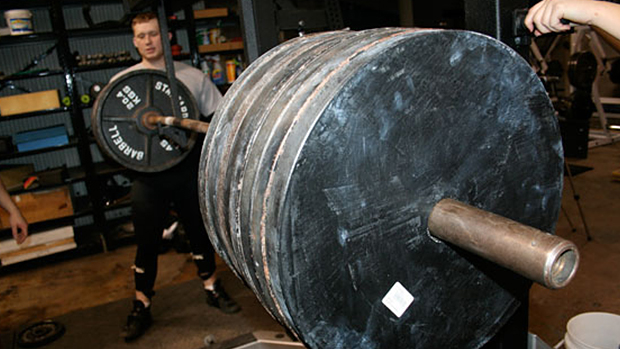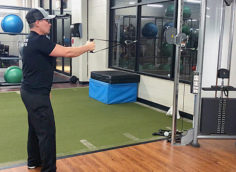Your doctor just told you to take six weeks off from lifting. Screwwww him! Here's how to heal that blown shoulder or
hamstring while still making progress!
Whether you're an athlete, competitive lifter, weekend warrior,
plumber, accountant, or secretary, chances are that you're gonna
get hurt sooner or later.
While some activities and lifestyles are more likely to result
in traumatic injuries than others, Kendall et al. have this to say
in Muscles: Testing and Function with Posture and Pain:
"Basic to the understanding of pain in relation to faulty posture
is the concept that the cumulative effects of constant or repeated
small stresses over a long period of time can give rise to the same
kind of difficulties that occur with a sudden, severe stress."
This idea, that accumulated stress can be just as damaging as an
acute trauma, explains why no athlete, neither powerlifter nor
ping-pong player, is completely free from the risk of injury. It's
how we deal with these injuries that allows us to continue to train
effectively during the recovery process.

No athlete is completely free from the risk of
injury.
Who Cares?
You should! Suffering an injury can have a profoundly negative
effect on your physique and mental health. I've seen countless
athletes go into a mild state of depression after getting hurt.
They tend to focus on all the things they can't do now that
they're hurt and abandon their training in favor of bed rest.
Generally, injuries necessitate complete rest to minimize
localized edema (swelling due to inflammation), for 2-7 days.
Considering the importance of training consistency, it's of
paramount importance that training resumes as soon as
possible.
The typical injury process goes something like:
• You get hurt
• You go to the doctor
• The doctor gives you drugs, and tells you what not to
do
• You take the drugs, and don't do what you're told not to
do
In The Proactive Patient,
Eric Cressey explains why you should go to your doc prepared with a
list of questions regarding what you can do to facilitate
recovery, opposed to just accepting their list of contraindicated
activities. Some doctors will be open to this conversation and
provide you with some better recommendations.
However, just like in every other profession, some doctors just
aren't good and probably won't give you much more than a, "You'd
better just lay off it for several weeks." As a personal example,
following an acromioclavicular (AC) joint separation that was
accompanied by a partial tear of the upper trapezius off the
posterior aspect of the distal clavicle, I had a collegiate sports
medicine doctor tell me I would never bench again, ever.
Thanks doc, for that very helpful prognosis.
So I basically ignored his pronouncement of doom, and embarked
on my own self-therapy, as follows:
Waking up the muscles responsible for scapular
stability
<!--
AC_FL_RunContent( 'codebase','http://download.macromedia.com/pub/shockwave/cabs/flash/swflash.cab#version=7,0,0,0','width','320','height','240','id','FLVPlayer','src','/FLVPlayer_Progressive','flashvars','&MM_ComponentVersion=1&skinName=/Clear_Skin_2&streamName=/img/photos/2008/08-117-training/ScapPush-Up&autoPlay=false&autoRewind=true','quality','high','scale','noscale','name','FLVPlayer','salign','lt','pluginspage','http://www.adobe.com/shockwave/download/download.cgi?P1_Prod_Version=ShockwaveFlash','movie','/FLVPlayer_Progressive' ); //end AC code
-->
<!--
Scap pushup
AC_FL_RunContent( 'codebase','http://download.macromedia.com/pub/shockwave/cabs/flash/swflash.cab#version=7,0,0,0','width','320','height','240','id','FLVPlayer','src','/FLVPlayer_Progressive','flashvars','&MM_ComponentVersion=1&skinName=/Clear_Skin_2&streamName=/img/photos/2008/08-117-training/StraightArmDBDips&autoPlay=false&autoRewind=true','quality','high','scale','noscale','name','FLVPlayer','salign','lt','pluginspage','http://www.adobe.com/shockwave/download/download.cgi?P1_Prod_Version=ShockwaveFlash','movie','/FLVPlayer_Progressive' ); //end AC code
Straight-arm dumbbell dip
AC_FL_RunContent( 'codebase','http://download.macromedia.com/pub/shockwave/cabs/flash/swflash.cab#version=7,0,0,0','width','320','height','240','id','FLVPlayer','src','/FLVPlayer_Progressive','flashvars','&MM_ComponentVersion=1&skinName=/Clear_Skin_2&streamName=/img/photos/2008/08-117-training/InvertedScapRow&autoPlay=false&autoRewind=true','quality','high','scale','noscale','name','FLVPlayer','salign','lt','pluginspage','http://www.adobe.com/shockwave/download/download.cgi?P1_Prod_Version=ShockwaveFlash','movie','/FLVPlayer_Progressive' ); //end AC code
Inverted scap row
AC_FL_RunContent( 'codebase','http://download.macromedia.com/pub/shockwave/cabs/flash/swflash.cab#version=7,0,0,0','width','320','height','240','id','FLVPlayer','src','/FLVPlayer_Progressive','flashvars','&MM_ComponentVersion=1&skinName=/Clear_Skin_2&streamName=/img/photos/2008/08-117-training/LatPulldownScapDepression2&autoPlay=false&autoRewind=true','quality','high','scale','noscale','name','FLVPlayer','salign','lt','pluginspage','http://www.adobe.com/shockwave/download/download.cgi?P1_Prod_Version=ShockwaveFlash','movie','/FLVPlayer_Progressive' ); //end AC code
Lat pulldown scap depression
-->
Improving internal ROM of the humerus
Like the pectoralis major, the fiber orientation of the
infraspinatus (one of the rotator cuff muscles) changes from a
horizontal direction to a more diagonal direction as you move from
the top down. In order to maximize the effectiveness of
stretching the external rotators, it makes sense to stretch these
muscles at two angles, 90¡ and 135¡.

2-way sleeper stretch – 90¡ Stretch

2-way sleeper stretch – 135¡ Stretch
Strengthening the rotator cuff
<!--
AC_FL_RunContent( 'codebase','http://download.macromedia.com/pub/shockwave/cabs/flash/swflash.cab#version=7,0,0,0','width','320','height','240','id','FLVPlayer','src','/FLVPlayer_Progressive','flashvars','&MM_ComponentVersion=1&skinName=/Clear_Skin_2&streamName=/img/photos/2008/08-117-training/LyingDBHumeralInteralrotation&autoPlay=false&autoRewind=true','quality','high','scale','noscale','name','FLVPlayer','salign','lt','pluginspage','http://www.adobe.com/shockwave/download/download.cgi?P1_Prod_Version=ShockwaveFlash','movie','/FLVPlayer_Progressive' ); //end AC code
-->
<!--
Lying internal rotation
-->
Improving grip strength
Try heavy dumbbell and barbell holds, focusing on squeezing the
bar as hard as possible for time.
To do these, load up a bar or grab a pair of dumbbells that you
can hold for about 20-30 seconds. Chalk up your hands.
Breathe in against a braced core, and pick up the bar.
Lock your shoulder blades back and down and squeeze the bar
as hard as possible for the allotted time.
To make this exercise slightly more difficult (and effective),
add a slight perturbation by rapidly performing small-amplitude
shrugging motions. The purpose of this is NOT to shrug the
weight all the way up, but to challenge your grip to a larger
extent. The light perturbations will make it feel like the
weight is prying your fingers open and challenging the reactive
performance of your rotator cuff musculature.
The exercises in the videos and pictures above aren't a
comprehensive list of everything I did, but after several months of
this therapy, I was able to bench again, pain-free. Doctor 0,
stubborn strength coach 1.
This morning I consulted with a female runner suffering from
knee pain. In her words, "I just want to know what I can do to keep
running." Now, there aren't enough hours in the day for my "I hate
distance running, especially for females" rant. However, I
restrained myself in this instance, because even if I gave it to
her, she wouldn't listen. Instead I showed her a few foam rolling
techniques, some glute activation exercises, and a couple of body
weight exercises to take her knees and hips through a full range of
motion.

A full range of motion is important for
running.
When athletes and lifters are passionately interested in
whatever it is they do, they don't want to hear that it's bad for
them. If you tell them it's detrimental to their health and they
should stop, they'll think you're an idiot, ignore you, and keep
doing what they're doing. I try to meet my athletes half way under
these circumstances. And if they do suffer an injury, there's always something they can still do. Almost everyone can and
should keep training hard.
What You Can Do
Assuming you have a unilateral injury, you should be training
the hell out of your good side. Not only will this provide the
psychological benefit of keeping your training intensity high, and
the physical benefit of keeping your "healthy side" strong, it'll
also significantly improve the strength of your injured side.
Significant improvements in strength can be gained without ever
moving the limb. This tactic may be a fair compromise between the
doctor's "you need to rest" and the athlete's "I need to stay
strong".
The idea that training one side results in strength improvements
on the contralateral side is referred to as cross-transfer or
cross-education and is well-established in the research literature.
Improvements are seen in both upper and lower extremity training,
with reported strength gains of the contralateral limb generally
between 10-77% of the healthy limb.(1-5) The large range is due to
the type of contractions used.
In general, isometric contractions produce the worst
contralateral carryover, and eccentric contractions produce the
best.(5) As you may expect, the contralateral benefit is also
movement-specific,(6) so you don't need to drop your squat,
deadlift, horizontal and vertical pressing and pulling patterns in
favor of single-joint exercises. Compound exercises will still
result in greater strength gains than single-joint exercises, even
in single limb training (the exception being the single-leg
stiff-legged deadlift, which is technically a single-joint
exercise).
While there is the idea that increased blood flow and consequent
oxygen delivery may be partially responsible for strength and
endurance improvements, the carryover is almost entirely due to
neural adaptations. As a result, you can train your good side to
maximize neural gains in strength and power exactly as you would if
you were healthy.
In consideration of the research, a few general guidelines are
to slow down the eccentric phase to a 3-5 second negative, maximize
concentric acceleration, use high intensity loads (just because
you're on one leg doesn't mean you need to take out the pink rubber
coated dumbbells), and perform 3-6 sets of 3-6 repetitions.
A few great exercises to include are:
1) Back leg raised stiff-legged deadlift
<!--
AC_FL_RunContent( 'codebase','http://download.macromedia.com/pub/shockwave/cabs/flash/swflash.cab#version=7,0,0,0','width','320','height','240','id','FLVPlayer','src','/FLVPlayer_Progressive','flashvars','&MM_ComponentVersion=1&skinName=/Clear_Skin_2&streamName=/img/photos/2008/08-117-training/BackLegRaisedStiff-LeggedDeadlift&autoPlay=false&autoRewind=true','quality','high','scale','noscale','name','FLVPlayer','salign','lt','pluginspage','http://www.adobe.com/shockwave/download/download.cgi?P1_Prod_Version=ShockwaveFlash','movie','/FLVPlayer_Progressive' ); //end AC code
-->
2) Single-leg stiff-legged deadlift
<!--
AC_FL_RunContent( 'codebase','http://download.macromedia.com/pub/shockwave/cabs/flash/swflash.cab#version=7,0,0,0','width','320','height','240','id','FLVPlayer','src','/FLVPlayer_Progressive','flashvars','&MM_ComponentVersion=1&skinName=/Clear_Skin_2&streamName=/img/photos/2008/08-117-training/1LegStiff-LeggedDeadlift&autoPlay=false&autoRewind=true','quality','high','scale','noscale','name','FLVPlayer','salign','lt','pluginspage','http://www.adobe.com/shockwave/download/download.cgi?P1_Prod_Version=ShockwaveFlash','movie','/FLVPlayer_Progressive' ); //end AC code
-->
3) Single-leg squat
<
AC_FL_RunContent( 'codebase','http://download.macromedia.com/pub/shockwave/cabs/flash/swflash.cab#version=7,0,0,0','width','320','height','240','id','FLVPlayer','src','/FLVPlayer_Progressive','flashvars','&MM_ComponentVersion=1&skinName=/Clear_Skin_2&streamName=/img/photos/2008/08-117-training/1LegBoxSquat&autoPlay=false&autoRewind=true','quality','high','scale','noscale','name','FLVPlayer','salign','lt','pluginspage','http://www.adobe.com/shockwave/download/download.cgi?P1_Prod_Version=ShockwaveFlash','movie','/FLVPlayer_Progressive' ); //end AC code
-->
4) Single-leg crossover squat
<!--
AC_FL_RunContent( 'codebase','http://download.macromedia.com/pub/shockwave/cabs/flash/swflash.cab#version=7,0,0,0','width','320','height','240','id','FLVPlayer','src','/FLVPlayer_Progressive','flashvars','&MM_ComponentVersion=1&skinName=/Clear_Skin_2&streamName=/img/photos/2008/08-117-training/1LegCrossoverSquat&autoPlay=false&autoRewind=true','quality','high','scale','noscale','name','FLVPlayer','salign','lt','pluginspage','http://www.adobe.com/shockwave/download/download.cgi?P1_Prod_Version=ShockwaveFlash','movie','/FLVPlayer_Progressive' ); //end AC code
-->
If you don't currently possess the strength or balance to
perform these movements, find a way to balance and unload yourself.
Heavy bands and cable columns serve this purpose
well.
Single-leg squat with heavy band
<!--
AC_FL_RunContent( 'codebase','http://download.macromedia.com/pub/shockwave/cabs/flash/swflash.cab#version=7,0,0,0','width','320','height','240','id','FLVPlayer','src','/FLVPlayer_Progressive','flashvars','&MM_ComponentVersion=1&skinName=/Clear_Skin_2&streamName=/img/photos/2008/08-117-training/Assisted1LegSquat&autoPlay=false&autoRewind=true','quality','high','scale','noscale','name','FLVPlayer','salign','lt','pluginspage','http://www.adobe.com/shockwave/download/download.cgi?P1_Prod_Version=ShockwaveFlash','movie','/FLVPlayer_Progressive' ); //end AC code
-->
Single-leg deadlift with contralateral cable
extension
<!--
AC_FL_RunContent( 'codebase','http://download.macromedia.com/pub/shockwave/cabs/flash/swflash.cab#version=7,0,0,0','width','320','height','240','id','FLVPlayer','src','/FLVPlayer_Progressive','flashvars','&MM_ComponentVersion=1&skinName=/Clear_Skin_2&streamName=/img/photos/2008/08-117-training/Assisted1LegStiff-LeggedDeadlift&autoPlay=false&autoRewind=true','quality','high','scale','noscale','name','FLVPlayer','salign','lt','pluginspage','http://www.adobe.com/shockwave/download/download.cgi?P1_Prod_Version=ShockwaveFlash','movie','/FLVPlayer_Progressive' ); //end AC code
-->
Performing these exercises while you're hurt should allow you to
improve, or at least maintain, the strength you have in your good
leg, and minimize the losses on your injured side. As an added
benefit, it'll allow you to keep pushing yourself, which will help
you keep a positive outlook on the experience. While this is beyond
my area of expertise, I know there's research in support of a
positive/optimistic outlook facilitating a faster recovery.
When your injury heals, remember that you haven't been loading
the spine heavily like you may in bilateral training (squats,
deadlifts, etc.), so you'll want to ease yourself back into these
exercises. It would be a tragedy for you to spend all this time and
energy training through an injury to have you strain a paraspinal
muscle on your first day back to squatting. It won't take long for
the strength of these muscles to return, so be smart (and patient).
You'll be stronger than ever in no time.
References
1. Enoka, R. (1997). Neural adaptations with chronic physical
activity. Journal of Biomechanics, 30,
447-455.
2. Munn, J., Herbert, R., & Gandevia, S. (2004).
Contralateral effects of unilateral resistance training: a
meta-analysis. Journal of Applied Physiology, 96,
1861-1866.
3. Lee, M., & Carrol, T. (2007). Cross Education: Possible
mechanisms for the contralateral effects of unilateral resistance
training. Sports Medicine, 37, 1-14.
4. Duchateau, J., & Enoka, R. (2002). Neural adaptations
with chronic activity patterns in able-bodied humans. American
Journal of Pysical Medicine & Rehabilitation, 81,
S17-S27.
5. Gabriel, D., Kamen, G., & Frost, G. (2006). Neural
adaptations to resistive exercise: Mechanisms and recommendations
for training practices. Sports Medicine, 36,
133-149.
6. Rutherford, O., & Jones, D. (1986). The role of learning
and coordination in strength training. European Journal of
Applied Physiology, 55, 100-105.





